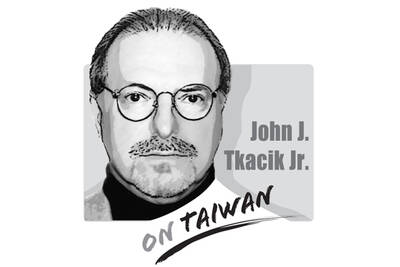The giant Rubber Duck inflatable sculptures have been one of the main social phenomena on Taiwan’s cultural calendar this year, with huge crowds attracted to the Glory Pier in the Port of Kaohsiung and a pond in Taoyuan’s Sinwu Township (新屋).
As far as tourism goes, they have been a spectacular success. The sculptures have been darlings of the media, and people — locals and tourists alike — have come in droves, generating considerable revenue on souvenirs and merchandise.
There is, however, a value gap between the cultural significance of these exhibits and the social and cultural fever they have created.
The ducks are the work of Dutch conceptual artist Florentijn Hofman, based on a bath toy many in the West will be familiar with, using its associations with the purity of childhood. The surreal effect created by their gargantuan proportions and their juxtaposition within the context of the environment in which they are placed evoke a mixture of reactions in the observer, from the inflatables’ towering aspect, the shock of the juxtaposition, the associations with purity, the implicit humor, and feelings of love and tenderness that, combined, have a strangely reassuring, soothing effect. The very familiarity of the image is at the root of its universal appeal.
Greater Kaohsiung took advantage of the rubber duck fever whipped up by the sculpture’s residency of Hong Kong’s Victoria Harbor the very minute its stint in Hong Kong ended. The city managed to bag an even bigger version of the duck to be sent over, before Shanghai got its own chance. The promotional literature tells us that the duck was 18m high, was made from 1 tonne of PVC, and was the largest version in Asia and the second-largest in the world. Naturally, size does matter, but for Taiwan the cultural significance is also important.
What exactly is the cultural significance of this creation or its connection to the local context?
The Taoyuan version of the duck is to be shown together with Japanese artist Yayoi Kusama’s Footprints of Life pink polka dot inflatable ladybugs and South Korean artist Choi Jeong-hwa’s giant pink Lotus in and around the township’s ponds as part of the Taoyuan Land Art Festival.
The point is and should be to allow passersby to reassess their relationship with the ponds and the land, thereby reinforcing the actual ecological and cultural context of Taiwan.
The duck is, after all, more than just a bathtime plaything. During the nation’s agricultural days, the duck was one of the main types of domesticated fowl, and its meat and eggs were major sources of protein in the Taiwanese diet. Ginger duck soup was a favorite winter warmer, and duck down the highest quality duvet filler. Live ducks made excellent farmyard watchdogs, warning of the approach of strangers, snakes or wild animals. They helped weed and fertilize the paddies, producing rice of the highest grade. The 1965 movie Beautiful Duckling (養鴨人家), starring Tang Pao-yun (唐寶雲), depicts a bygone life of agricultural Taiwan, so remote to us now. And then there was Chu Yi-kui (朱一貴), the duck farmer who led the 1721 anti-Qing Manchu uprising in Taiwan, who has gone down in Taiwanese folklore.
If Taiwan wants to promote its culture, it first needs to learn how to tell its own story. It needs to better make these events relevant to the experience and cultural context of the majority of people. Otherwise, we will find that when it is all over and the hype has calmed down, we are left with nothing. Over time, this illustrates Taiwan’s current cultural anemia.

Somehow, US intelligence identified “the Houthis’ top missile guy” and pinpointed his exact location. At 1348 hours (Washington time), March 15, President Trump’s national security advisor Mike Waltz texted, “positive ID of him walking into his girlfriend’s building.” The unsuspecting Romeo entered. High above, the drone monitoring the building registered a flash. When the smoke cleared, Mr. Waltz texted, “…And it’s now collapsed.” RIP. The star-crossed “top missile guy” had been target number one in the now uproarious US Navy bombing campaign on that Sunday against the Yemeni rebels who have been holding the Red Sea hostage since October 19,
China on Tuesday, April Fool’s Day, began two-day joint-force military exercises around Taiwan, painting them as a “severe warning and forceful containment against Taiwan independence.” However, the exercises have again proven the country increasingly showcasing its military muscles to be a true “troublemaker.” Without prior notice, the Chinese People’s Liberation Army’s (PLA) Eastern Theater Command launched large-scale exercises codenamed “Strait Thunder-2025A,” deploying aircraft, drones and naval vessels including the Shandong aircraft carrier, as well as armed militia in the air and waters around Taiwan. The PLA claimed the military exercises were practice for precision strikes and a blockade to “close
Days ago, foreign media reported that Chinese People’s Liberation Army (PLA) Eastern Theater Command Director Lin Xiangyang (林向陽) is suspected to have disappeared under suspicious circumstances. The Eastern Theater Command is the core military department responsible for operations against Taiwan — the purging of its director, if true, would be a major blow to the morale of the Chinese military and the success of its training. On Tuesday morning — April Fool’s Day — the Chinese Communist Party’s (CCP) Eastern Theater Command suddenly announced the launch of joint military exercises in the air and maritime spaces surrounding Taiwan. The exercises
During the four-day Tomb Sweeping Festival holiday, many recall campaigns set up temporary stalls in their electoral districts to encourage more eligible voters to sign second-phase recall petitions. As of Wednesday, a total of 47 recall efforts — targeting 35 Chinese Nationalist Party (KMT) lawmakers and 12 Democratic Progressive Party (DPP) lawmakers — had advanced to the second phase, which requires signatures from at least 10 percent of eligible voters in the constituency within 60 days to proceed to a final vote. Nearly all recall petitions against KMT legislators cleared the first-phase review and launched their second phase between March 8 and